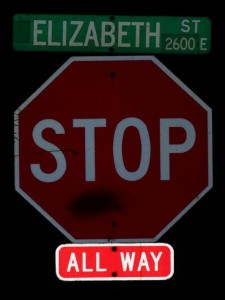Example of Visual Nighttime Inspection
We all see traffic signs on all roads, which provide all types of information necessary for operating our vehicles safely. What many drivers do not know is that traffic signs are required to maintain a minimum level of retroreflectivity.
What is retroreflectivity? In simplest terms, it is the light that returns to the user from the light source, which in most cases is an automobile’s headlights.
Governmental agencies are required to ensure their signs meet or exceed retroreflectivity standards established by the Federal Highway Administration (FHWA). They accomplish this requirement by implementing an assessment or management methodology to ensure traffic signs adhere to uniform standards defined by the FHWA.
The two most widely used assessment methods are Visual Nighttime Inspection and Measured Sign Retroreflectivity. They are defined as follows:
- Visual Nighttime Inspection is performed at night by a trained inspector from a moving vehicle with the headlights on low beam.
- Measured Sign Retroreflectivity is measured by a retroreflectometer. These devices are typically very expensive and tend to be cost prohibitive for small agencies.
The three most widely used management methods are Expected Sign Life, Blanket Replacement, and Control Signs. They are defined as follows:
- Expected Sign Life is measured from the date of installation of the sign by labeling and recording. There are many factors that affect a sign’s retroreflectivity like geographical area, the direction the sign is facing and type of reflective sheeting just to name a few.
- Blanket Replacement is just what the name implies, in that all signs are replaced in a specified area. Some agencies segregate their city or county into sectors, with one sector getting replaced each year.
- The Control Signs method is a group of signs normally maintained in a maintenance yard. They are erected at the same time signs are installed on the streets, and when they fail to meet the minimum standards, all signs associated with that control group are replaced.
Meeting the Minimum Retroreflectivity Standards established by FHWA is not an option…it is a requirement. For further information about upgrading to these standards, please contact Vulcan Signs today! 1.800.633.6845 | vulcan3@vulcaninc.com
#VulcanSigns #retroreflectivity #trafficsigns #transportationsigns #highwaysigns #fhwa #stopsigns #madeintheusa #foleyalabama #manufacturing
 Vulcan Corporate
Vulcan Corporate
 Sheets, Blanks & Extrusions
Sheets, Blanks & Extrusions
 Custom Stamping & Laser Cutting
Custom Stamping & Laser Cutting
 Traffic Control & Commercial Signage
Traffic Control & Commercial Signage
 Aluminum Coil in Multiple Tempers, Gauges & Widths
Aluminum Coil in Multiple Tempers, Gauges & Widths
 Utility Signs, Markers & Related Products
Utility Signs, Markers & Related Products








Very interesting information!
Thanks, Josh! Glad you enjoyed it!